The dark web has always been shrouded in mystery. It tends to be associated with illegal actions, black markets, and all manner of shady things occurring away from the public eye, and there is certainly an element of truth to that. Tech and security enthusiasts, as well as privacy advocates, also find the dark web useful for discovering or learning about online privacy tools, cyber security, and other, often sensitive information. But with great power also comes great responsibility, and while accessing its narrative dark web is some kind of thrill, it’s a perilous thrill that must be done with care.
This blog will walk you through what is dark web, how to enter the dark web, the required tools, safe practices and how to avoid risks. Regardless of whether you’re doing some sleuthing or just wondering, this guide has got you covered.
What Is the Dark Web?
The dark web is one aspect of the deep web, which can’t be indexed by search engines such as Google or Bing. Instead, dark web sites need a special kind of software to access them – Tor Browser. These sites are called dark web links or.” onion” domain name, written to be untraceable.
So what is the Dark Web really? And how does it differ from, the Deep Web?

Dark web is a part of the Deep web
Although the words “dark web” and “deep web“ are sometimes used interchangeably, they have distinct meanings. “Deep web” covers parts of the Internet that are not indexed by search engines as the main search engines do not have access to them. That includes things such as private emails, online banking portals and paid subscription services, and documents stored in cloud services — anything that one might need authentication to access, or that isn’t intended to be public and searchable online. The deep web is a very important part of internet, containing sensitive and legal information which is accessed and used daily by people and companies.
In contrast, the dark web is but a sliver of the deep web and is intentionally hidden. This is only available through specific software - the Tor Browser. Unlike the deep web which is used for legitimate reasons, the dark web when mentioned is used to refer to anonymous forums or marketplaces, as well as illicit material which is not legal to share. Not all activities on the dark web are criminal, but it’s often used for things like selling illegal wares or talking about topics away from prying eyes.
The Deep Web Iceberg Concept

To help you get a comparison of the deep web and dark web in your head, lets imagine the internet is an iceberg. The tip of the iceberg sticking out above the water represents the surface web — the part of the internet you use every day with search engines like Google or Bing. This applies to internet sites, blogs and social media also.
Hidden underwater below the tip of the iceberg is the deep web. This is where all this sensitive, private and protected content, such as databases, academic resources, and financial records, we referred to earlier is stored. It’s wide, essential, but usually harmless — just beyond our sight.
At the very bottom lies the dark web. This is the deepest and most secretive part of the internet. It’s tiny compared to the rest of the deep web, but its anonymity and encryption make it hard to police. This is the place where you can locate the good, the bad, and the extremely ugly content that has made the dark web what it is.
By picturing the internet as an iceberg, you see how much is hidden below the surface, and why it is important to know the difference between the deep web and the dark web.
Illicit though some dark web content may be, it’s not all that is found there. The dark web has legitimate uses that are often shut under the banner of banning hateful and extortive websites, sites for whistle-blowers, such as ProPublica’s SecureDrop, academic resources, like Sci-Hub, or the Hidden Wiki, which provides dark web directories. But a journey of the dark web demands right tools, caution and responsibility.
Requirements: What You’ll Need to Access the Dark Web
But first, as you prepare to enter the dark web, you’ll need a few things just to make sure you can access it, and do so without compromising your identity
Tor Browser
It’s the Tor Browser that you access the dark web through. It operates by passing your internet traffic through a volunteer overlay network, using various ports that are anonymous. Unlike regular browsers, it’s been created for to come. onion websites.
Getting Tor Browser: It is for Windows, macOS, Linux and Android, and you can use it to visit dark web sites while keeping your identity protected online.
VPN (Virtual Private Network)
The main way to combat this is by using a VPN to encrypt your internet connection and hide your IP address. Though the Tor Browser already includes a means to be anonymous, when you use VPN in addition to Tor, this ensures that your ISP can’t monitor you’re using Tor.
Recommended VPNs include:
Pro Tip:
Always have your VPN on before you open your Tor Browser.
How to Visit the Dark Web first time: A Step-by-Step Guide
The dark web doesn’t have to be confusing. Here’s what you need to know to stay safe on Fabric.
Step 1: Load Up with a Dependable VPN
Before you do anything, use your favorite VPN to encrypt your connection. Select a server in a safe location and turn on your VPN.
2) Navigate To And Install Tor Browser

Navigate to the Tor Project site to download the Tor Browser, according to your device.
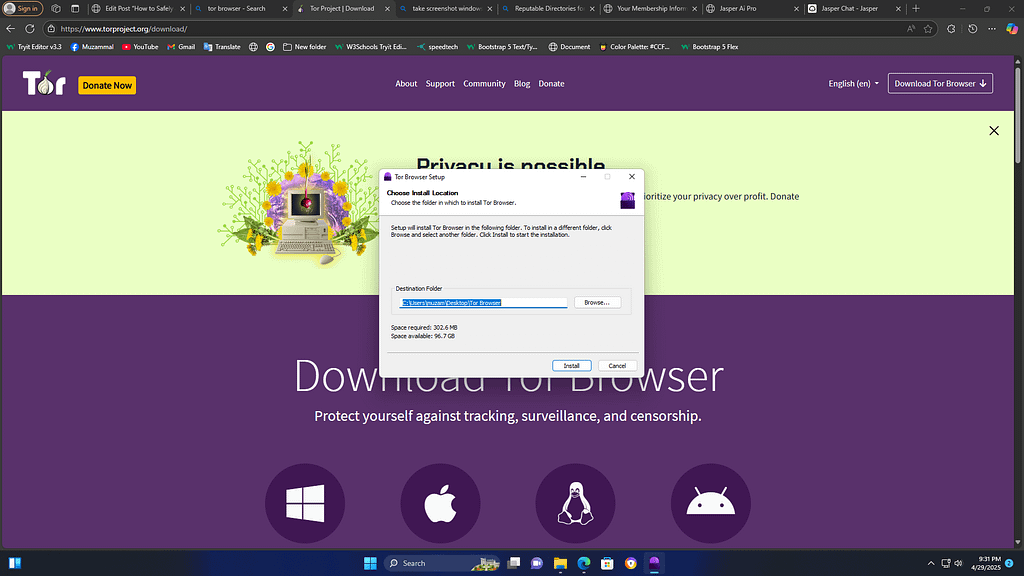
Step 3: Open the Tor Browser
After you have installed the Tor Browser, you will have to open it. It will probably connect to the network in a second.
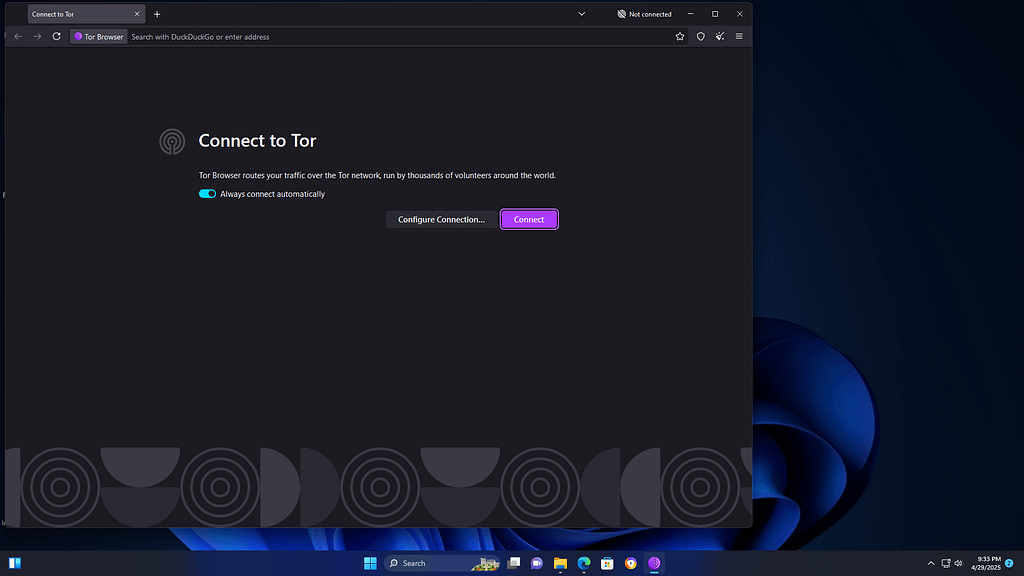
Pro tip: Do not maximize the tor browser window. Some experts say that by maximizing the tor browser to windows size your information could be leaked. Because a powerful hacker might track your windows size and information might get leaked.
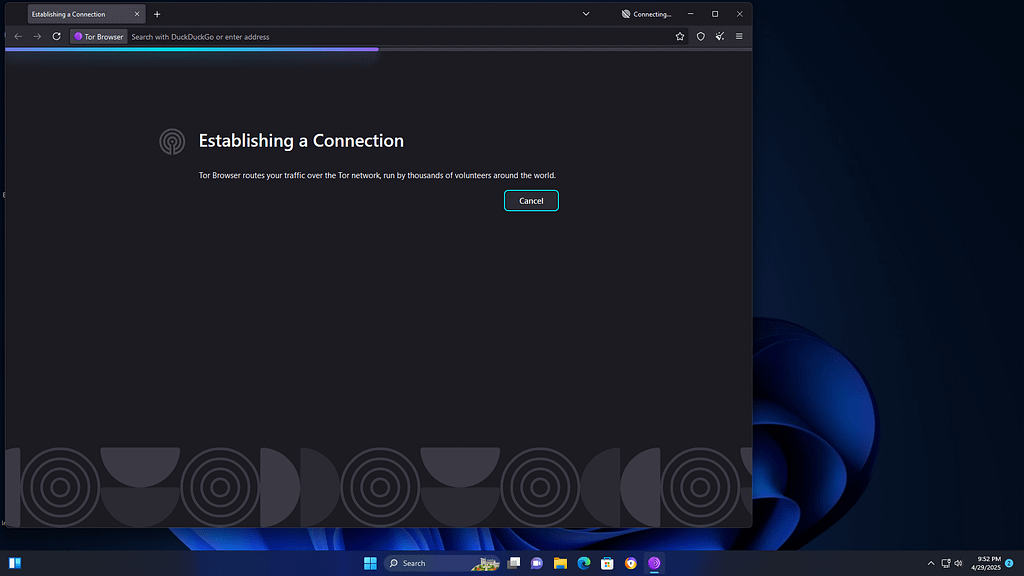
Step 4: Access the Dark Web
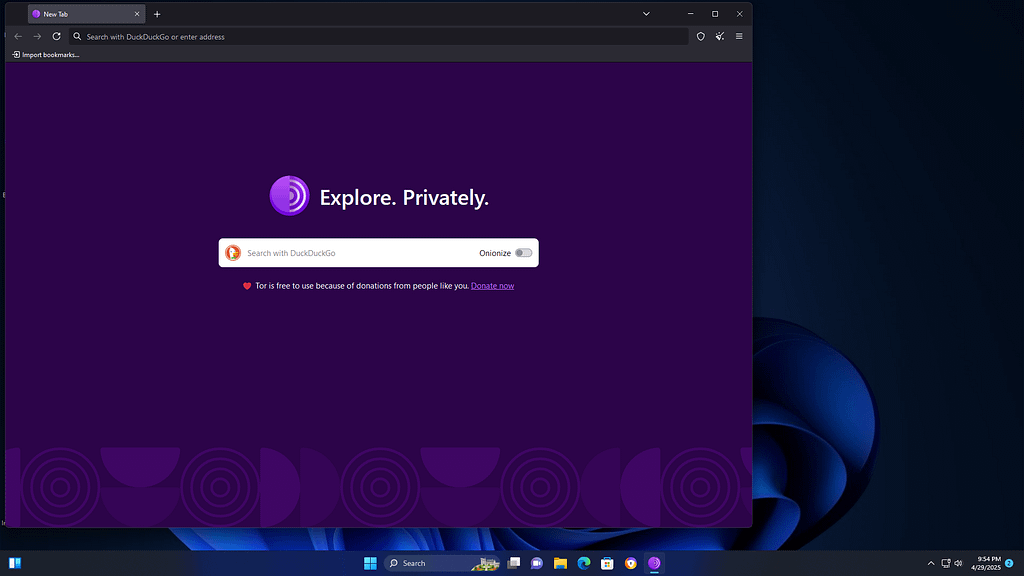
Begin with well-respected directories (lists are given below) such as the Hidden Wiki or the dark web search engine “Ahmia.” They’ll help you find legitimate dark web sites, like ProPublica or Sci-Hub.
Step 5: Explore Responsibly
Stick to legal avenues of discovery in your search, and resist the urge to click on unsafe links.
Protecting Yourself from the Dark Web
When checking out dark web links, security is of the highest priority. Not following best practices completely could leave you vulnerable to malware, scams or even legal problems. Here’s what you can do:
Don’t Give Away Too Much Information
Never enter any personal information, like your name, email, or credit card number, on dark web sites. This can help shield you from identity theft and online surveillance.
Disable JavaScript
JavaScript can be used by cybercriminals to run malicious code. Make sure it’s always disabled in Tor Browser for the most security.
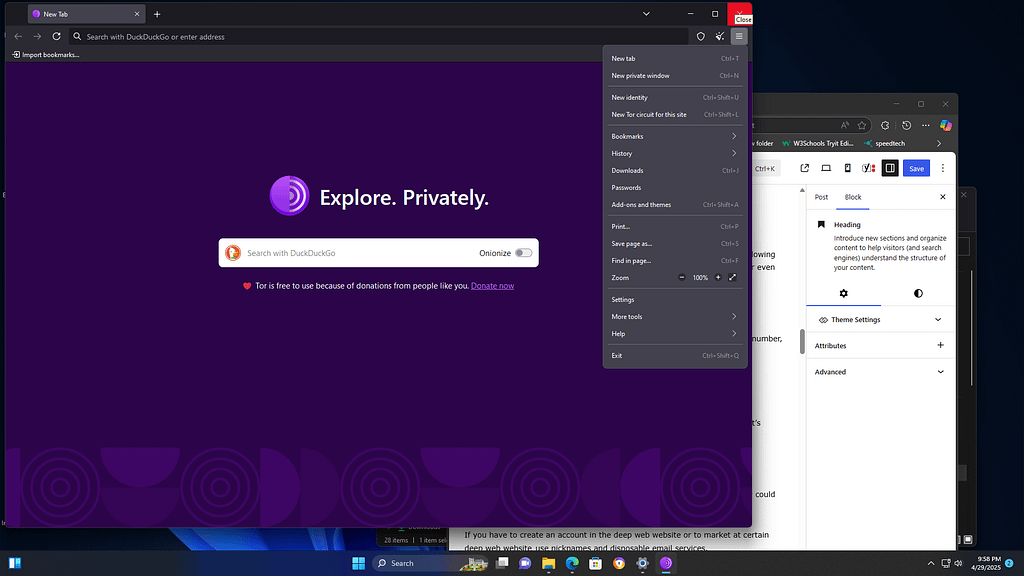
For disabling javascript From right corner go to settings as like shown on the top and type java on the search bar
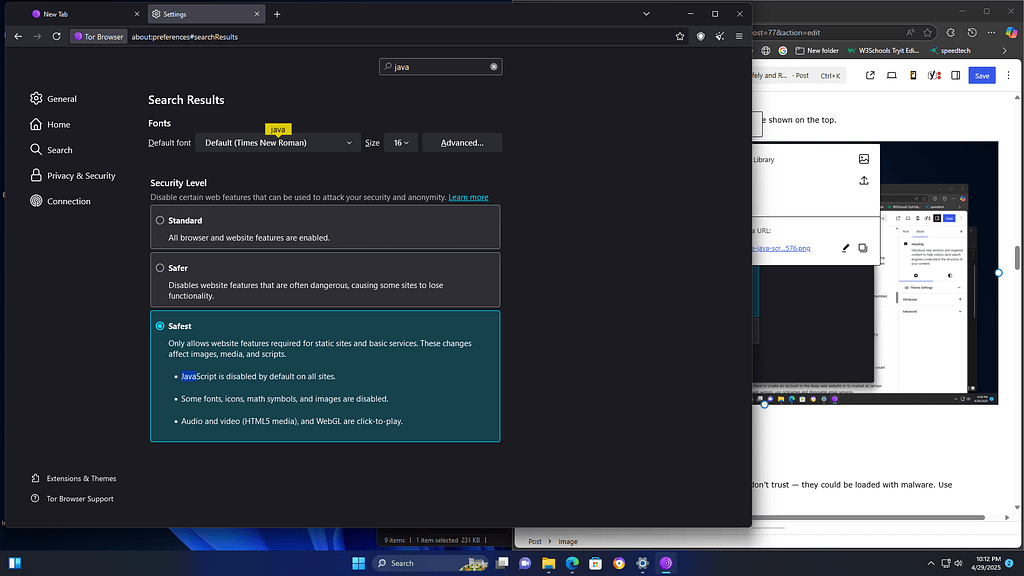
Select the safest
Be Mindful of Downloads
Don’t download files from sources that you don’t know or don’t trust — they could be loaded with malware. Use Pseudonymous Accounts
If you have to create an account in the deep web website or to market at certain deep web website use nicknames and disposable email services.
Avoid Illegal Activities
Is the dark web illegal? Not all of them, but many of the activities and sites on the dark web are. Make sure as always that your search is consistent with the laws in your area.
How to Navigate the Dark Web
The dark web can seem daunting at first. Here are a few ways to begin
Use Reputable Directories
Here are some reputable directories and search engines for exploring the dark web safely:
- The Hidden Wiki: A categorized directory of .onion sites, offering a starting point for exploring the dark web. It includes both legitimate and questionable links, so caution is advised.
- Ahmia: A search engine that indexes .onion sites while filtering out harmful or illegal content. It provides a safer way to explore the dark web.
- DuckDuckGo: Known for its privacy-focused search engine, DuckDuckGo also has a .onion version, making it a popular choice for secure browsing on the dark web.
- Torch: One of the oldest and most extensive dark web search engines, offering uncensored search results.
- ProPublica: A Pulitzer Prize-winning investigative journalism site with a .onion version for secure access.
- SecureDrop: A platform for whistleblowers to share sensitive information securely and anonymously.
- The New York Times: Offers a .onion site to provide access to news in regions with heavy censorship.
When exploring the dark web, always use tools like the Tor browser and a VPN for added security. Be cautious of malicious links and avoid sharing personal information.
these are some common reputable directories. If can find more reputable directories give their name/link in the comment section. You could find them by searching in the surface web search engine like google or duckduckgo.com.

Be security-conscious and privacy-aware.
Use a VPN: Before diving into the dark web, connect through a reputable VPN to hide your IP address and location. There’s now a second degree of anonymity.
Keep Tor Browser Up to Date: Keep your Tor browser current, which gives you the latest in security and vulnerabilities.
Turn off JavaScript: Switch off Javascript in the Tor browser to minimize tracking and stop any bad scripts running.
Start with Caution
**Stick to Verified Links
Leverage Secure Platforms
ProPublica\ SecureDrop: For secure communications for whistleblowers and by journalists.
Sci-Hub: To download scientific researches.
Avoid Illegal Marketplaces
Underground web bazaars are frequently havens for scams, knockoffs and illicit operations. Avoid such platforms to save yourself from legal and security issues.
Risks and Risk Mitigation
The dark web is a double-edged sword. Here are some of the most prevalent risks and how to address them:
Malware and Viruses: Some malware may exist on dark web websites. Protect against malware with an antivirus program and say no to downloads.
Scammers: Be VERY careful with any deals or interactions. How to purchase on the dark web is often obscured by scammers who demand upfront payment with no intention of delivering what you’ve bought.
Surveillance: Even though the Tor Browser itself encrypts your traffic, certain activities can still be tracked by governments or cybercriminals. A VPN provides another layer of defense against snoops.
Legal Trouble:
In some countries, browsing the dark web is illegal. Understand the laws in your local area, and only check out legal sources.
Some Dark Web Incident that is Worth Noting
incident 1
A significant moment for the dark web came in 2013 with the fall of Silk Road, which at its peak was a multimillion-dollar platform for selling drugs, false identities and computer hacking tools. Silk Road was run by Ross Ulbricht under the alias “Dread Pirate Roberts”, and became a black market for the purchase and sale of drugs, forged documents and other illicit goods. The FBI finally closed the site, arrested Ulbricht, and confiscated millions in Bitcoin. The dark web nature Both the sheer volume of dark web activity and the and the lengths to which law enforcement agencies will go to disrupt illicit operations. It was also a harsh reminder that while the dark web may seem anonymous, it is not without its policing and legal consequences.
incident 2
A second headline-grabbing attack on the dark web was a hacking to scrape a giant database that reverberated throughout the infosec world. 2021 Hacker forum A hacker forum appeared in 2021 alleging that they have access to sensitive information of millions of users of a well-known social media platform. The compromised information was said to have included names, email addresses, phone numbers, as well as other account-related data, thus leaving the victims at risk of identity theft and scams. The hacker put the database up for sale on the dark web, asking for cryptocurrency in return. This is just another reminder of the potential threats that the average user is susceptible to when they browse the internet without proper cybersecurity and stolen information that flows through dark markets, as its buyers become criminals who profit of off unexciting users with unsuspecting attitude to their own security, in this case, not only to the users but also to the companies as well.
What’s On The Dark Web and Where’s It Located: The Good, Bad, And In-between Resurgence of the Dark Web Ethical Uses of the Dark Web
There are no bad digital outlets, but similar to any tool and instrument, it has to be utilized responsibly. Responsible use of dark web services involves using them for research, privacy, and access to law. Whether you’re downloading a research paper from Sci-Hub or are learning about democracy-empowering tools such as SecureDrop, you have a role to play in the ecosystem.
Final Thoughts on the Dark Web Accessing the dark web may seem relatively easy, but it’s not without its dangers.
There’s a lot to be desired about the dark web for those who care about privacy – and those who enjoy the mystery! Whether you want to know how to access the dark web safely or you’re just curious about what type of content you’ll be able to find, there’s a right way and a wrong way to find dark web websites — and to protect yourself while you’re exploring them.
As always, safety first, don’t break the law and have a goal when you’re out there. If you’re ready to begin your explorations on this hidden corner of the internet, be sure to follow the advice and steps outlined in this guide to ensure you have a safe and productive experience.
Also, read before purchasing something from the dark web: How to Safely Purchase on the Dark Web: A Step-by-Step Guide to Access the Dark Web Responsibly




[…] you want to know how to access dark web, you’ll learn the ins and outs of it right here: the how to, the main uses, and the most […]
[…] If you are interested dark web, you can read How to Safely and Responsibly Use the Dark Web […]